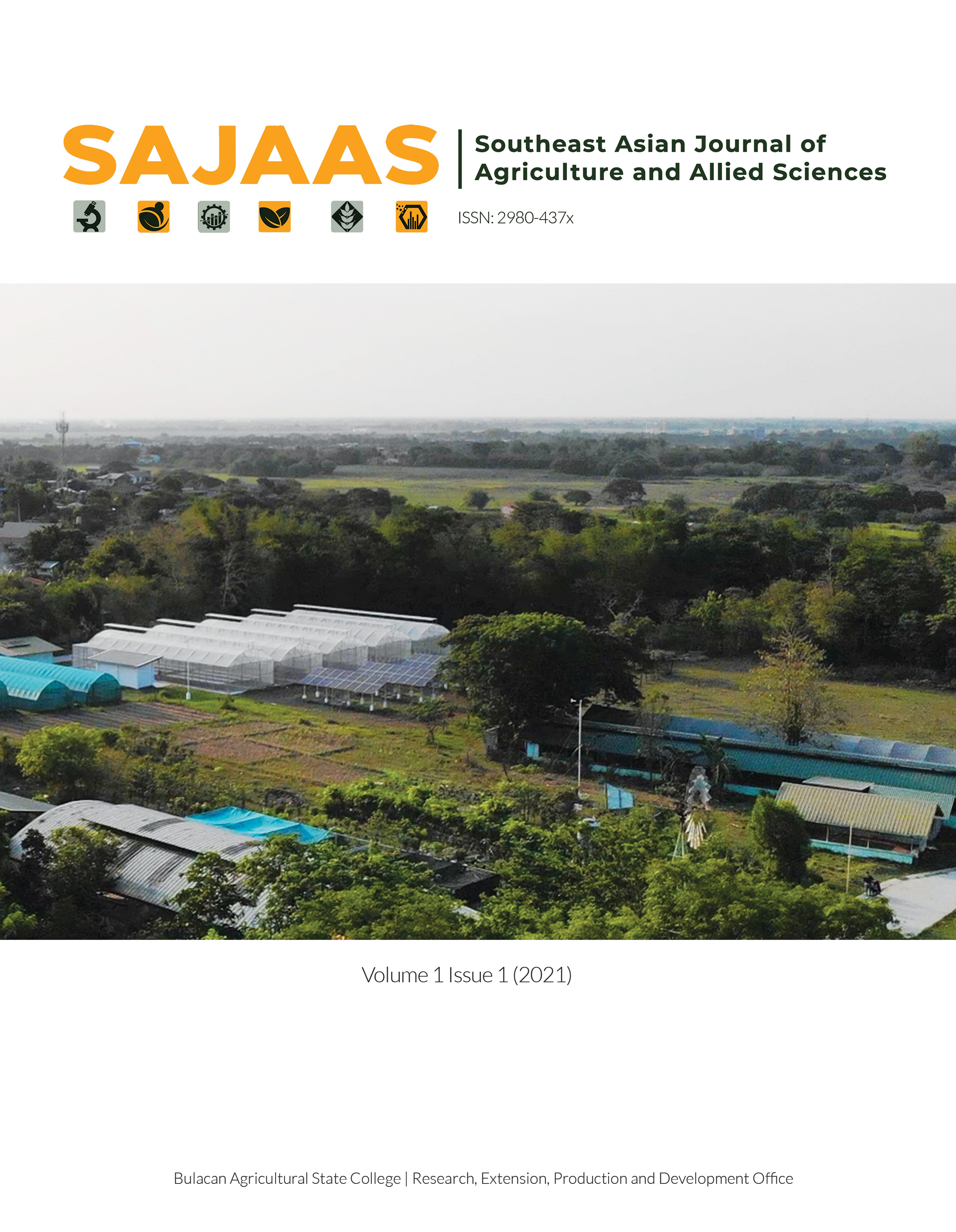Abstract
To evaluate the growth performance of mallard ducks fed azolla as partial replacement of soybean meal, a study was carried out from April 6, 2020 to June 6, 2020 in San Ildefonso, Bulacan. A total of apparently healthy, 180 heads of 15-day-old mallard ducks (90 female and 90 male) were used in the study with 2 x 3 factorial experiment in Completely Randomized Design (CRD). Factor A was the sex of ducks while Factor B was the level of substitution. Mallard ducks with a 10% substitution level were significantly better than the 20% substitution level in terms of weight gain, feed consumption, feed conversion ratio (FCR), and ROI. Further analysis on the dressing percentage revealed that there was no significant effect on the sex of ducks, level of substitution and interactions between the two factors. The results of the study revealed that the azolla meal diets have nutritive and feeding values based on the proximate analysis being conducted. It was concluded that Azolla at 10% level in the diet improved gain in body weight, feed consumption and FCR especially on both sexes of ducks. Using mash rations with the inclusion of Azolla at 10% level could be used as substitutes for soya bean meal on mallard duck diet. All these facts suggested further study on other level of substitutions of Azolla to soybean nmeal to gain additional knowledge about its effects, study focusing on only one sex of mallard duck to further analyze the economics and tried to other animals, such as swine and ruminants, as an alternative source of protein with 10% level of substitution, and educate and encourage farmers through training and seminars to raise and produce azolla in order to make it readily available to animals, especially during lean months, as arable areas for feed crops are declining due to the higher populations of both humans and animals.
References
Basak, M. Pramanik, A. H., Rahman, M. S., Tarafdar,S. U. and Roy, B. C., (2002). Azolla (Azolla pinnata) as a feed Ingredient in broiler ration. Int. J. Poult. Sci., 1 (1): 29- 34.
Balaji, K., Jalaludeen, A., Churchil, R. R., Peethambaran, P. A., Senthilkumar, S., (2009). Effect of dietary inclusion of Azolla (Azolla pinnata) on production performance of broiler chicken. Indian. J. Poult. Sci., 44 (2):195-198.
Buckingham K.W., Ela S.w., Morris J.G., and Goldman C.R. (1978). Nutritive value of the nitrogen-fixingaquatic fern Azolla filiculoides. J. Agric Food Chem.26: 1230-1234.
Castillo, S.L. (1982). Azolla in broiler diets. Livestock and Poultry Research News. Los Banos, Laguna: UPCA, X No.3.
Different Types of Feed - Mash, Crumbles and Pellets. (n.d.). Retrieved September 5, 2022, from https://metzerfarms.blogspot.com/2017/11/different-types-of-feed-mash-crumbles.html
Jagdish. (2020, July 12). Azolla as Livestock Feed (Animals/Poultry/Fish). Agri Farming. Retrieved September 5, 2022, from https://www.agrifarming.in/azolla-as-livestock-feed-animals-poultry-fish
Kumar, M., Dhuria, R.K., Jain, D., Nehra, R., Sharma, T., Prajapat, U. K., Kumar, S., and Siya, S.S., (2018). Effect of Inclusion of Sun-Dried Azolla (Azolla pinnata) at Different Levels on the Growth and Performance of Broiler Chick. Department of Animal Nutrition, College of Veterinary and Animal Science, Bikaner, Rajasthan University of Veterinary and Animal Sciences, Bikaner, Rajasthan, INDIA.
Magpantay Va, Lambio Al, Laude Rp, Reaño Ce, Diaz Mgq. (2019). Genetic Diversity of Philippine Mallard Duck (Anas platyrhynchos domesticus L.) based on SSR Markers. Philipp J Sci 148(4): 733–741.
Naghshi, H., Khojasteh, S. and Jafari, M. (2014). Investigation of the effect of different levels of Azolla (Azolla pinnata) on performance and characteristics of Cobb broiler Chicks. Int. J. Farming Allied Sci., 3(1): 45-49.
Philippine Council for Agriculture, Aquatic and Natural Resources Research and Development-Department of Science and Technology. (2015). Philippine Recommend for Livestock Feed Formulation
Philippine Statistics Authority. (2022). Duck Situation Report: January–December 2020. Retrieved on 5 Sept 2022 from https://psa.gov.ph/sites/default/ files/1_%20SR%20Duck% 20Annual% 20Situation%20%20Report_signed.pdf
Philippine Statistics Authority. (2021). Duck Situation Report: January–December 2020. Retrieved on 23 Nov 2021 from https://psa.gov.ph/sites/default/ files/1_%20SR%20Duck% 20Annual% 20Situation%20%20Report_signed.pdf
Shamna, T. P., Peethambaran, P. A., Jalaludeen, A., Joseph L. and aslam M. K., (2013). Broiler characteristics of japenese quails (Coturnix coturnix japonica) at different levels of diet substitution with Azolla pinnata. Anim. Sci. Reporter, 7 (2): 75-80.
Sontakke, U., Kale, V., Bose, B. and Kumar, M., (2014). Non-Conventional Feeds and Agro Industrial by Products: Their Scope and Future Demand for Livestock Production (Dairy Cattle Nutrition Division National Dairy Research Institute). Retrieved: Sept. 5, 2022.https://en.engormix.com/feed-machinery/articles/non-conventional-feeds-agro-t36183.htm.
Steczny, K., D. Kokoszynski, Z. Bernacki, R. Wasilewski and M. Saleh, (2017). Growth performance, body measurements, carcass composition and some internal organ characteristics in young Pekin ducks. S. Afr. J. Anim. Sci., 47: 399-406.
Vipriyanti, N. U., Lyulianti, S. P., Puspawati, D. A., Handayani, M. E., Tariningsih, D., & Malung, Y. U. (2021, November). The efficiency of duck rice integrated system for sustainable farming. In IOP Conference Series: Earth and Environmental Science (Vol. 892, No. 1, p. 012008). IOP Publishing.

This work is licensed under a Creative Commons Attribution-NonCommercial-ShareAlike 4.0 International License.
Copyright (c) 2022 Southeast Asian Journal of Agriculture and Allied Sciences

